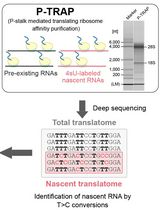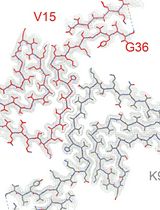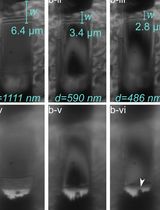- EN - English
- CN - 中文
Purification and Cryo-electron Microscopy Analysis of Plant Mitochondrial Ribosomes
植物线粒体核糖体的纯化和低温电镜分析
(*contributed equally to this work) 发布: 2021年08月05日第11卷第15期 DOI: 10.21769/BioProtoc.4111 浏览次数: 4041
评审: Anu P. MinhasDr. Kalpa MehtaSneha RayAnonymous reviewer(s)
Abstract
Plants make up by far the largest part of biomass on Earth. They are the primary source of food and the basis of most drugs used for medicinal purposes. Similarly to all eukaryotes, plant cells also use mitochondria for energy production. Among mitochondrial gene expression processes, translation is the least understood; although, recent advances have revealed the specificities of its main component, the mitochondrial ribosome (mitoribosome). Here, we present a detailed protocol to extract highly pure cauliflower mitochondria by differential centrifugation for the purification of mitochondrial ribosomes using a sucrose gradient and the preparation of cryo-electron microscopy (cryo-EM) grids. Finally, the specific bioinformatics pipeline used for image acquisition, the processing steps, and the data analysis used for cryo-EM of the plant mitoribosome are described. This protocol will be used for further analysis of the critical steps of mitochondrial translation, such as its initiation and regulation.
Keywords: Plant mitochondria (植物线粒体)Background
Mitochondria are essential organelles that act as both energy conversion powerhouses and metabolic hubs in eukaryotic cells. Mitochondria contain a genome and fully functional gene expression machinery. These gene expression complexes combine traits inherited from prokaryotic ancestors and specific features acquired during eukaryotic evolution (Gray, 2015; Waltz and Giegé, 2020). Mitochondrial research has huge societal implications given that numerous diseases are linked to mitochondrial dysfunctions in humans and many other eukaryotes (Nunnari and Suomalainen, 2012; De Silva et al., 2015). For instance, in plants, male sterility resulting from recombined mitochondrial DNA is a trait widely used in agronomy (Chen and Liu, 2014). Among mitochondrial gene expression processes, translation is considered the most important in terms of regulation since it is clear that transcriptional processes are not limiting for mitochondrial gene expression. Still, the mechanistic details of translational regulation, and even the basic composition of the translational machinery, remain poorly understood for many eukaryotes. Recent functional, biochemical, and structural data have revealed an unexpected diversity of mitochondrial translation systems, in particular of their key players, the mitochondrial ribosomes (mitoribosomes) in diverse eukaryotes (Waltz and Giegé, 2020). In particular, the mitoribosomes of the land plant Arabidopsis thaliana and cauliflower were recently characterized at the biochemical and structural levels, revealing their unique and unexpected features such as the occurrence of novel domains and additional plant-specific ribosomal proteins (Waltz et al., 2019, 2020a and 2020b). This represents the first examples of mitoribosome characterization in photosynthetic organisms. These major advances have only been possible as a result of the recent advances in cryo-electron microscopy (cryo-EM) techniques, acknowledged by the Nobel Prize in Chemistry to J. Frank, J. Dubochet, and R. Henderson in 2017 (Cressey and Callaway, 2017). Cryo-EM is an electron microscopy technique that is used to investigate the structure of various types of biomolecules from single proteins to large complexes such as ribosomes. The technique relies on imaging isolated macromolecules and complexes that are embedded in vitreous water on a microscopy grid. To do so, the liquid sample containing the biomolecules is flash-frozen to cryogenic temperatures in liquid ethane. Thanks to this process, the complexes can conserve their native organization and structure. Near atomic resolution structures, and even atomic structures (Nakane et al., 2020), of biological complexes, can be obtained through computational processing and averaging of multiple images, which ultimately allow 3D reconstruction of the complexes.
While ribosome purification and analysis by cryo-EM have been described elsewhere (Aibara et al., 2018), the protocol described herein details the specific procedures required to prepare the individual plant mitoribosome large subunit (LSU) and small subunit (SSU) and to single out the intact 78S plant mitoribosome monosomes. In addition to the specific steps for the biochemical preparation of plant mitoribosome samples, the protocol also describes the specific bioinformatics pipeline used for the cryo-EM analysis of plant mitoribosome samples. Although significant progress has recently been made in this field, numerous questions remain completely unexplored, such as how the mitoribosome interacts with the mitochondrial membrane insertase systems, how translation initiation functions, and how translation is regulated. The protocol described herein will be instrumental in helping to solve these key questions regarding plant mitochondrial translation.
Materials and Reagents
Mitochondria purification
D-Mannitol (Sigma-Aldrich, catalog number: M4125)
Sodium pyrophosphate (Na4P2O7·10H2O) (Sigma-Aldrich, catalog number: 71515-250G)
BSA: Bovine serum albumin (EUROMEDEX, catalog number: 04-100-812-C)
Polyvinylpyrrolidone-25 (Sigma-Aldrich, catalog number: 81400)
β-Mercaptoethanol (Sigma-Aldrich, catalog number: M6250)
EDTA (Sigma-Aldrich, catalog number: EDS)
L-Cysteine (Sigma-Aldrich, catalog number: W326305)
Phosphate buffer 1 M, pH 7.5
Miracloth (Milipore, catalog number: 475855)
Percoll® (Sigma-Aldrich, catalog number: P1644)
PierceTM Coomassie (Bradford) Protein Assay Kit (Sigma-Aldrich, catalog number: 23200)
3× Extraction buffer (see Recipes)
Wash buffer (see Recipes)
28% Percoll® gradient (see Recipes)
Mitoribosome purification
1.5-ml Eppendorf tubes
HEPES-KOH (EUROMEDEX, catalog number: 10-110-C)
KCl (Sigma-Aldrich, catalog number: P9541)
MgCl2 (Sigma-Aldrich, catalog number: M8266)
DTT: DL-Dithiothreitol (Sigma-Aldrich, catalog number: D0632)
Triton X-100 (Sigma-Aldrich, catalog number: X100)
n-DDM: n-Dodecyl β-D-maltoside (Sigma-Aldrich, catalog number: D4641)
Sucrose (Sigma-Aldrich, catalog number: S7903)
Complete EDTA-free protease inhibitor cocktail (Sigma-Aldrich, catalog number: 11873580001)
Liquid ethane
Liquid nitrogen (N2)
Lysis buffer (see Recipes)
40% Sucrose cushion (see Recipes)
Resuspension buffer (see Recipes)
10-30% Sucrose gradient (see Recipes)
Final resuspension buffer (see Recipes)
10% n-DDM (see Recipes)
50% Triton X-100 (see Recipes)
Equipment
Mitochondria purification
KIMBLE® Dounce tissue grinders, 15-ml and 2-ml (Sigma-Aldrich, catalog number: D8938)
Juice extractor, Moulinex Type 140.2.03 or equivalent
Centrifuge (Beckman Coulter, model: AVANTI-JE or equivalent), able to take JA-10 and JA-25.5 rotors
JA-25.5 fixed-angle rotor 8 × 50-ml Beckman Coulter or equivalent
JA-25.5 tubes: Round centrifuge tube polycarbonate, 50-ml (Nalgene, catalog number: 3117-0500)
JA-10 fixed-angle rotor 6 × 500-ml Beckman Coulter or equivalent
F500 bottles: Centrifuge bottle with sealing cap, PPCO, 500-ml (Nalgene, catalog number: 3141-0500)
Benchtop centrifuge (e.g., Eppendorf, model: 5427R)
A round-type paintbrush (e.g., Windsor & Newton watercolor sable n°10)
Mitoribosome purification
BioComp gradient master 108
BioComp piston gradient fractionator
Ultracentrifuge (Beckman Coulter, model: OPTIMA XE90, or equivalent), able to take 60Ti and SW41 rotors
Fixed-angle rotor 8 × 38.5-ml (Beckman Coulter, model: 60 Ti or equivalent)
60 Ti tubes: 26.3-ml Polycarbonate bottle with cap assembly (Beckman Coulter, catalog number: 355618)
Swinging rotor 6 × 13-ml (Beckman Coulter, model: SW41 Ti or equivalent)
SW41 Ti tubes: 13.2-ml, Open-top thinwall ultra-clear tube (Beckman Coulter, catalog number: 344059)
Ultracentrifuge (Beckman Coulter, model: OPTIMA MAX XP or equivalent), able to take a TLA110 rotor
Fixed-angle rotor 8 × 5.1-ml (Beckman Coulter, model: TLA110 or equivalent)
A rotating wheel for 1.5-ml tubes
Mitoribosome cryo-grid preparation and data collection
Quantifoils R2/2 EM grids (Electron Microscopy Sciences, catalog number: Q210CR2)
Cryo-grid box storage
Safematic CCU-010 carbon coater or equivalent (Labtech-em, catalog number: 100001)
Glow discharge system from ELMO or equivalent
Thermo Fisher Vitrobot Mark IV or equivalent
Thermo Fisher Talos Artica 200kV or Titan Krios 300kV cryo-EM microscope or equivalent
Falcon III direct detector device or equivalent/superior (e.g., Gatan Summit K2, K3, Falcon IV)
Software
RELION (MRC laboratory, https://www3.mrc-lmb.cam.ac.uk/relion/index.php/Main_Page)
CryoSPARC (Structura Biotechnology Inc, https://cryosparc.com/)
MotionCor2 (Shawn Zheng) (https://emcore.ucsf.edu/ucsf-software)
Gctf (Zhang, 2016; https://www2.mrc-lmb.cam.ac.uk/research/locally-developed-software/zhang-software/)
Resmap (http://resmap.sourceforge.net/)
Chimera (UCSF, https://www.cgl.ucsf.edu/chimera/)
Procedure
文章信息
版权信息
© 2021 The Authors; exclusive licensee Bio-protocol LLC.
如何引用
Waltz, F., Giegé, P. and Hashem, Y. (2021). Purification and Cryo-electron Microscopy Analysis of Plant Mitochondrial Ribosomes. Bio-protocol 11(15): e4111. DOI: 10.21769/BioProtoc.4111.
分类
生物物理学 > 显微技术 > 低温显微镜技术
微生物学 > 微生物生物化学 > RNA
分子生物学 > RNA > mRNA 转译
您对这篇实验方法有问题吗?
在此处发布您的问题,我们将邀请本文作者来回答。同时,我们会将您的问题发布到Bio-protocol Exchange,以便寻求社区成员的帮助。
Share
Bluesky
X
Copy link












